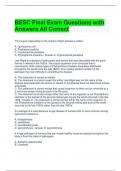Exam (elaborations)
BESC Final Exam Questions with Answers All Correct
- Course
- Institution
BESC Final Exam Questions with Answers All Correct The fungus responsible for the chestnut blight disease is called: A. Ophiostoma ulmi B. Phakopsora pakirizi C. Cryphonectria parasitica D. Phytophthora infestans - Answer-C. Cryphonectria parasitica Late Blight is a disease of both pot...
[Show more]



